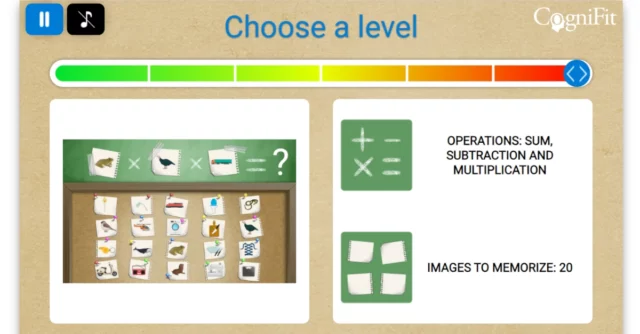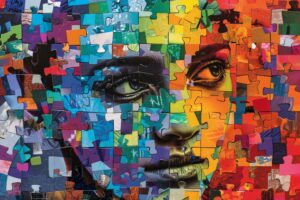
Math Madness Game – Images & Equations to Improve Memory
If the word “math” gives you the cold sweats and stressful flashbacks to high school calculus, you’re not alone. But don’t let that stop you from trying this month’s brain game feature Math Madness!
First, you can rest easy knowing that math itself is quite simple. Second, it’s actually your Recognition and various types of Memory processes that you’ll be exercising. So, let’s dive into how the game works as well as take a look at what brain functions you’ll be flexing while you play.
How to Play Math Madness

First, you’ll be prompted to choose a level of difficulty. As always, it’s a very good idea to start at the lowest level, so you can get an idea of how things work. You don’t want to discourage yourself by diving into the deep end and feeling overwhelmed!
At low levels, you’ll start with simple math – like addition or subtraction. You’ll also only have a few pictures to memorize.
The game works in an “alternation” process.
- First, you’ll see images and their point values. For example, an elephant might be worth 10 points and a book might be worth 2.
- On the next screen, you’ll see a set of new images. These have no point values. All you have to do is remember what you see.

- Next, you’ll see the “point value” pictures again. But this time with no numbers. There are only “total sum” possibilities at the bottom of the screen. You have to choose the correct one. For example, if you see the violin and the fridge, you would clock the 9 out of the answers below.
- Finally, the second set of pictures will appear. But this time some of them will be different, and you have to click on those.
As levels get harder the equations have sums with multiplication and subtraction etc., and image sets of 20 to memorize.
So, you can see that Math Madness uses math, but also images to force you to use your memory. But what kinds of memory are you exercising? Let’s take a look…
Non-Verbal Memory
Nonverbal memory is the ability to code, store, and recover information about faces, shapes, images, songs, sounds, smells, tastes, and feelings. Nonverbal memory is what makes it possible to retain and remember content without words (written or spoken).
Depending on how long the information stays in our memory and depending on the type of processing that it undergoes, memory can be divided into Sensory memory, Short-term memory, Working Memory, or Long-term memory.
Also, how we perceive the information, it can be divided into Visual and Spatial Short-term Memory, Haptic memory (touch), Olfactory memory (smell), and Gustatory memory (taste).
It’s obvious that this kind of memory is really important for our everyday lives. And although people might associate problems with Non-Verbal Memory with things like Alzheimer’s Disease or other dementias, it can also happen with people who suffer from depression.

Phonological Short-Term Memory
This is also called echoic memory, and it’s one of the sensory memory registries. Basically, it’s the sound wave information that reaches your ear and gets stored before going to the rest of your brain to be processed. It’s in charge of all of the short-term phonologic information that we receive from our environment. It also lasts a few seconds longer than visual memory. And in brain-terms, that’s a lot!
What makes this kind of memory really amazing is that it’s really resistant to brain injury. People with brain damage often still have PSTM intact!
Short-Term Memory
Short-term memory is exactly what you think is it. It’s the brain’s ability to store information for a short period of time. After that, it either goes into the brain for long-term storage or fades away.
The thing is if you think your short-term memory is bad, did you know that it only has a finite amount of space for everyone? Yep!
For example, if you are asked to remember a sequence of 10 digits, you’ll likely be able to remember between 5 and 9 numbers. This is because the amount of information short-term is able to retain is 7 elements, with a variation of 2, either more or less. We can also, on average, only hold onto something for around 30 seconds.
Short-term memory acts as an access door to long-term memory, or like a storage room that makes it possible to retain information that we won’t necessarily need in the future, but that we need at the moment. And even though there’s not much to work with, we can still exercise this brain function to make it a little bit stronger or more efficient.

Recognition
Recognition is really just the brain’s ability to identify “stimuli”, like situations, places, people, objects, etc. that you’ve seen before.
The funny thing is we can have a “false” reaction with Recognition.
- A False Positive is where we think we recognize something we’ve never seen before. Like seeing a store we’ve never shopped at but think we did.
- A False Negative is when we don’t recognize something we have seen before. Like seeing someone we have met previously.
The goal is to have fewer false reactions as possible – especially in things like driving, work, or academics.
Math Madness Conclusion
Now, we see how this game uses simple equations and pictures to work key areas of our brain when it comes to memory. So, why not give it a try? When it comes to brain health and building neural plasticity, all you need is 20 minutes a day 3 times a week! Go to CogniFit to learn more!














